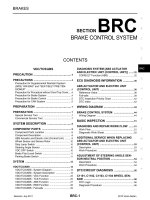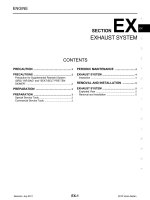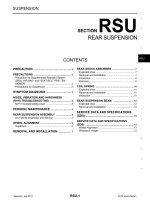RSU hệ THỐNG GIẢM sóc SAU TRÊN NISSAN VERSA SEDAN 2012
Bạn đang xem bản rút gọn của tài liệu. Xem và tải ngay bản đầy đủ của tài liệu tại đây (346.96 KB, 13 trang )
RSU-1
SUSPENSION
C
D
F
G
H
I
J
K
L
M
SECTION RSU
A
B
RSU
N
O
P
CONTENTS
REAR SUSPENSION
PRECAUTION 2
PRECAUTIONS 2
Precaution for Supplemental Restraint System
(SRS) "AIR BAG" and "SEAT BELT PRE-TEN-
SIONER"
2
Precautions for Suspension 2
SYMPTOM DIAGNOSIS 3
NOISE, VIBRATION AND HARSHNESS
(NVH) TROUBLESHOOTING
3
NVH Troubleshooting Chart 3
PERIODIC MAINTENANCE 4
REAR SUSPENSION ASSEMBLY 4
On-Vehicle Inspection and Service 4
WHEEL ALIGNMENT 5
Inspection 5
REMOVAL AND INSTALLATION 7
REAR SHOCK ABSORBER 7
Exploded View 7
Removal and Installation 7
Inspection 8
Disposal 8
COIL SPRING 10
Exploded View 10
Removal and Installation 10
Inspection 10
REAR SUSPENSION BEAM 12
Exploded View 12
Removal and Installation 12
SERVICE DATA AND SPECIFICATIONS
(SDS) 13
SERVICE DATA AND SPECIFICATIONS
(SDS)
13
Wheel Alignment 13
Wheelarch Height 13
Revision: July 2011 2012 Versa Sedan
RSU-2
< PRECAUTION >
PRECAUTIONS
PRECAUTION
PRECAUTIONS
Precaution for Supplemental Restraint System (SRS) "AIR BAG" and "SEAT BELT
PRE-TENSIONER"
INFOID:0000000007774175
The Supplemental Restraint System such as “AIR BAG” and “SEAT BELT PRE-TENSIONER”, used along
with a front seat belt, helps to reduce the risk or severity of injury to the driver and front passenger for certain
types of collision. This system includes seat belt switch inputs and dual stage front air bag modules. The SRS
system uses the seat belt switches to determine the front air bag deployment, and may only deploy one front
air bag, depending on the severity of a collision and whether the front occupants are belted or unbelted.
Information necessary to service the system safely is included in the SR and SB section of this Service Man-
ual.
WARNING:
• To avoid rendering the SRS inoperative, which could increase the risk of personal injury or death in
the event of a collision which would result in air bag inflation, all maintenance must be performed by
an authorized NISSAN/INFINITI dealer.
• Improper maintenance, including incorrect removal and installation of the SRS, can lead to personal
injury caused by unintentional activation of the system. For removal of Spiral Cable and Air Bag
Module, see the SR section.
• Do not use electrical test equipment on any circuit related to the SRS unless instructed to in this
Service Manual. SRS wiring harnesses can be identified by yellow and/or orange harnesses or har-
ness connectors.
PRECAUTIONS WHEN USING POWER TOOLS (AIR OR ELECTRIC) AND HAMMERS
WARNING:
• When working near the Airbag Diagnosis Sensor Unit or other Airbag System sensors with the Igni-
tion ON or engine running, DO NOT use air or electric power tools or strike near the sensor(s) with a
hammer. Heavy vibration could activate the sensor(s) and deploy the air bag(s), possibly causing
serious injury.
• When using air or electric power tools or hammers, always switch the Ignition OFF, disconnect the
battery, and wait at least 3 minutes before performing any service.
Precautions for Suspension INFOID:0000000007208076
• When installing rubber bushings, the final tightening must be carried out under unladen conditions with tires
on ground. Spilled oil might shorten the life of rubber bushings. Be sure to wipe off any spilled oil.
- Unladen conditions mean that fuel, engine coolant and lubricant are full. Spare tire, jack, hand tools and
mats are in designated positions.
• After servicing suspension parts, be sure to check wheel alignment.
• Self-lock nuts are not reusable. Always use new ones when installing. Since new self-lock nuts are pre-oiled,
tighten as they are.
• The tightening surface must be kept free of oil/grease.
• When jacking up the vehicle with a floor jack, never hang the jack on the suspension beam.
Revision: July 2011 2012 Versa Sedan
NOISE, VIBRATION AND HARSHNESS (NVH) TROUBLESHOOTING
RSU-3
< SYMPTOM DIAGNOSIS >
C
D
F
G
H
I
J
K
L
M
A
B
RSU
N
O
P
SYMPTOM DIAGNOSIS
NOISE, VIBRATION AND HARSHNESS (NVH) TROUBLESHOOTING
NVH Troubleshooting Chart INFOID:0000000007208077
Use chart below to find the cause of the symptom. If necessary, repair or replace these parts.
×: Applicable
Reference page
RSU-7, RSU-10, RSU-12
RSU-7
—
—
RSU-10
RSU-7, RSU-10, RSU-12
RSU-5
RAX-4, "NVH Troubleshooting Chart"
RSU-7, RSU-10, RSU-12
WT-36, "NVH Troubleshooting Chart"
WT-36, "NVH Troubleshooting Chart"
BR-7, "NVH Troubleshooting Chart"
Possible cause and SUSPECTED PARTS
Improper installation, looseness
Shock absorber deformation, damage or deflection
Bushing or mounting deterioration
Parts interference
Spring fatigue
Suspension looseness
Incorrect wheel alignment
REAR AXLE AND REAR SUSPENSION
TIRE
ROAD WHEEL
BRAKE
Symptom
Noise ×××××× × ×××
Shake ×××× × × ×××
Vibration ××××× × ×
Shimmy ×××× × × ×××
Shudder ××× × ×××
Poor quality ride or handling ××××× × × ××
Revision: July 2011 2012 Versa Sedan
RSU-4
< PERIODIC MAINTENANCE >
REAR SUSPENSION ASSEMBLY
PERIODIC MAINTENANCE
REAR SUSPENSION ASSEMBLY
On-Vehicle Inspection and Service INFOID:0000000007208078
Make sure the mounting conditions (looseness, backlash) of each component and component conditions
(wear, damage) are within specifications.
SHOCK ABSORBER INSPECTION
Check shock absorber for oil leakage, damage and replace it if necessary.
Revision: July 2011 2012 Versa Sedan
WHEEL ALIGNMENT
RSU-5
< PERIODIC MAINTENANCE >
C
D
F
G
H
I
J
K
L
M
A
B
RSU
N
O
P
WHEEL ALIGNMENT
Inspection INFOID:0000000007208079
DESCRIPTION
CAUTION:
• The adjustment mechanisms of camber and toe-in are not included.
• If camber and toe-in is outside the standard, check front suspension parts for wear and damage.
Replace suspect parts if a malfunction is detected.
Measure wheel alignment under unladen conditions.
NOTE:
“Unladen conditions” means that fuel, engine coolant, and lubricant are full. Spare tire, jack, hand tools and
mats are in designated positions.
PRELIMINARY CHECK
Check the following:
• Tires for improper air pressure and wear. Refer to WT-45, "
Tire Air Pressure".
• Road wheels for runout.
• Wheel bearing axial end play. Refer to RAX-9, "
Inspection".
• Shock absorber operation.
• Each mounting point of axle and suspension for looseness and deformation.
• Each of rear suspension beam and shock absorber for cracks, deformation, and other damage.
• Vehicle height (posture).
GENERAL INFORMATION AND RECOMMENDATIONS
1. A Four-Wheel Thrust Alignment should be performed.
• This type of alignment is recommended for any NISSAN vehicle.
• The four-wheel “thrust” process helps ensure that the vehicle is properly aligned and the steering wheel
is centered.
• The alignment machine itself should be capable of accepting any NISSAN vehicle.
• The alignment machine should be checked to ensure that it is level.
2. Make sure the alignment machine is properly calibrated.
• Your alignment machine should be regularly calibrated in order to give correct information.
• Check with the manufacturer of your specific alignment machine for their recommended Service/Cali-
bration Schedule.
THE ALIGNMENT PROCESS
IMPORTANT: Use only the alignment specifications listed in this Service Manual. Refer to RSU-13,
"Wheelarch Height".
1. When displaying the alignment settings, many alignment machines use “indicators”: (Green/red, plus or
minus, Go/No Go). Do NOT use these indicators.
• The alignment specifications programmed into your alignment machine that operate these indicators
may not be correct.
• This may result in an ERROR.
2. Most camera-type alignment machines are equipped with both "Rolling Compensation" method and
optional "Jacking Compensation" method to "compensate" the alignment targets or head units. "Rolling
Compensation" is the preferred method.
• If using the "Rolling Compensation" method, after installing the alignment targets or head units, push or
pull on the rear wheel to move the vehicle. Do not push or pull the vehicle body.
• If using the "Jacking Compensation" method, after installing the alignment targets or head units, raise
the vehicle and rotate the wheels 1/2 turn both ways.
NOTE:
Do not use the "Rolling Compensation" method if you are using sensor-type alignment equipment.
• Follow all instructions for the alignment machine you're using for more information.
CAMBER
• Measure camber of both right and left wheels with a suitable alignment gauge.
• If camber is outside specified range, replace rear suspension beam. Refer to RSU-12, "
Exploded View".
Camber : Refer to RSU-13, "
Wheel Alignment".
Revision: July 2011 2012 Versa Sedan
RSU-6
< PERIODIC MAINTENANCE >
WHEEL ALIGNMENT
TOE-IN
Measure toe-in by the following procedure.
WARNING:
• Always perform the following procedure on a flat surface.
• Check that no person is in front of vehicle before pushing it.
1. Bounce the front of vehicle up and down to stabilize the vehicle height (posture).
2. Push vehicle straight ahead about 5 m (16 ft).
3. Put matching mark (A) on base line of the tread (rear side) of
both tires at the same height of hub center. These are measur-
ing points.
4. Measure distance (A) (rear side).
5. Push vehicle slowly ahead to rotate wheels 180 degrees (1/2
turn).
NOTE:
If the wheels rotates more than 180 degrees (1/2 turn), start this
procedure again from the beginning. Do not push the vehicle
backward.
6. Measure distance (B) (front side).
• If toe-in is outside specified range, replace rear suspension beam. Refer to RSU-12, "
Exploded View".
JPEIA0014ZZ
: Vehicle front
Total toe-in = A − B
Total toe-in : Refer to RSU-13, "
Wheel Alignment".
JPEIA0015ZZ
Revision: July 2011 2012 Versa Sedan
REAR SHOCK ABSORBER
RSU-7
< REMOVAL AND INSTALLATION >
C
D
F
G
H
I
J
K
L
M
A
B
RSU
N
O
P
REMOVAL AND INSTALLATION
REAR SHOCK ABSORBER
Exploded View INFOID:0000000007208080
Removal and Installation INFOID:0000000007208081
REMOVAL
1. Remove the wheel and tire assembly using power tool.
2. Remove wheel sensor and sensor harness. Refer to BRC-104, "
REAR WHEEL SENSOR : Removal and
Installation".
3. Position a suitable jack under rear suspension beam.
CAUTION:
• Place the jack in the center of the suspension beam.
• Do not damage the suspension beam with jack.
4. Remove the lower shock absorber bolt.
5. Remove trunk side finisher. Refer to INT-32, "
TRUNK SIDE FINISHER : Removal and Installation".
6. Remove the upper shock absorber nut, washer and bushing.
7. Remove shock absorber assembly.
8. Remove bushing, distance tube, bound bumper cover, and bound bumper from shock absorber assembly.
INSTALLATION
Installation is in the reverse order of removal.
• Perform final tightening of bolts and nuts at the shock absorber lower side (rubber bushing), under unladen
conditions with tires on level ground.
1. Piston rod lock nut 2. Washer 3. Bushing
4. Distance tube 5. Bound bumper cover 6. Bound bumper
7. Shock absorber assembly 8. Rear suspension beam
AWEIA0209GB
Revision: July 2011 2012 Versa Sedan
RSU-8
< REMOVAL AND INSTALLATION >
REAR SHOCK ABSORBER
• Install bushing into the hole on the vehicle side as shown.
• Hold the head (A) of shock absorber piston rod (1) to keep it from
rotating, and tighten piston rod lock nut.
• Perform inspection after installation. Refer to RSU-8, "
Inspection".
• After replacing the shock absorber, always follow the disposal pro-
cedure to discard the shock absorber. Refer to RSU-8, "
Disposal".
Inspection INFOID:0000000007208082
INSPECTION AFTER REMOVAL
Shock Absorber
Check the following items, and replace the part if necessary.
• Shock absorber for deformation, cracks, and other damage.
• Piston rod for damage, uneven wear, and distortion.
• Oil leakage
Bound Bumper, Bushing
Check for cracks and damage. Replace it if necessary.
Washer, Bound Bumper Cover, Distance Tube
• Check for cracks and damage. Replace it if necessary.
INSPECTION AFTER INSTALLATION
Check wheel alignment. Refer to RSU-5, "Inspection".
Disposal INFOID:0000000007208083
1. Set shock absorber horizontally to the ground with the piston rod fully extracted.
2. Drill 2 – 3 mm (0.08 – 0.12 in) hole at the position ( ) from top
as shown in the figure to release gas gradually.
CAUTION:
• Wear eye protection (safety glass).
• Wear gloves.
• Be careful with metal chips or oil blown out by the com-
pressed gas.
NOTE:
• Drill vertically in this direction.
• Directly to the outer tube avoiding brackets.
• The gas is clear, colorless, odorless, and harmless.
3. Position the drilled hole downward and drain oil by moving the piston rod several times.
JPEIB0227ZZ
JPEIB0241ZZ
A : 20 – 30 mm (0.79 – 1.18 in)
JPEIA0161ZZ
Revision: July 2011 2012 Versa Sedan
REAR SHOCK ABSORBER
RSU-9
< REMOVAL AND INSTALLATION >
C
D
F
G
H
I
J
K
L
M
A
B
RSU
N
O
P
CAUTION:
Dispose of drained oil according to the law and local regulations.
Revision: July 2011 2012 Versa Sedan
RSU-10
< REMOVAL AND INSTALLATION >
COIL SPRING
COIL SPRING
Exploded View INFOID:0000000007208084
Removal and Installation INFOID:0000000007208085
REMOVAL
1. Remove the wheel and tire assemblies using power tool.
2. Position a suitable jack under rear suspension beam.
CAUTION:
• Place the jack in the center of the suspension beam.
• Do not damage the suspension beam with jack.
3. Remove the lower shock absorber bolts. Refer to RSU-7, "
Removal and Installation".
4. Slowly lower jack, then remove upper rubber seat, coil spring and lower rubber seat from rear suspension
beam.
INSTALLATION
Installation is in the reverse order of removal.
• Install the lower rubber seat (A) to the rear suspension beam
mounting hole (B).
• Match up lower rubber seat indentions and rear suspension beam
grooves and attach.
Inspection INFOID:0000000007208086
INSPECTION AFTER REMOVAL
Check rubber seat and coil spring for deformation, crack, and damage. Replace it if necessary.
INSPECTION AFTER INSTALLATION
1. Upper rubber seat 2. Coil spring 3. Lower rubber seat
4. Rear suspension beam
JPEIB0162ZZ
JPEIB0223ZZ
Revision: July 2011 2012 Versa Sedan
COIL SPRING
RSU-11
< REMOVAL AND INSTALLATION >
C
D
F
G
H
I
J
K
L
M
A
B
RSU
N
O
P
Check wheel alignment. Refer to RSU-5, "Inspection".
Revision: July 2011 2012 Versa Sedan
RSU-12
< REMOVAL AND INSTALLATION >
REAR SUSPENSION BEAM
REAR SUSPENSION BEAM
Exploded View INFOID:0000000007208087
Removal and Installation INFOID:0000000007208088
REMOVAL
1. Remove the wheel and tire assemblies using power tools.
2. Remove wheel sensor and sensor harness. Refer to BRC-104, "
REAR WHEEL SENSOR : Removal and
Installation".
3. Remove brake hose and brake pipe from rear suspension beam. Refer to BR-25, "
REAR : Removal and
Installation".
4. Remove the rear drum brake assemblies. Refer to BR-41, "
Removal and Installation".
5. Remove parking brake cable from rear suspension beam. Refer to PB-6, "
Removal and Installation".
6. Position a suitable jack under rear suspension beam.
CAUTION:
• Place the jack in the center of the suspension beam.
• Do not damage the suspension beam with jack.
7. Remove shock absorber bolts (lower side). Refer to RSU-7, "
Removal and Installation".
8. Remove coil spring. Refer to RSU-10, "
Removal and Installation".
9. Remove rear suspension beam bolts and nuts.
10. Slowly lower jack, remove rear suspension beam from vehicle body.
CAUTION:
While lowering the rear suspension beam with the jack, be sure to maintain the stability of the
jack.
INSTALLATION
Installation is in the reverse order of removal.
• Perform final tightening of rear suspension beam installation position (rubber bushing), under unladen condi-
tions with tires on level ground.
• Check wheel sensor harness for proper connection. Refer to BRC-104, "
REAR WHEEL SENSOR :
Exploded View".
• Adjust parking brake. Refer to PB-4, "
Inspection and Adjustment".
• Check wheel alignment. Refer to RSU-5, "
Inspection".
1. Rear suspension beam
JPEIB0254GB
Revision: July 2011 2012 Versa Sedan
SERVICE DATA AND SPECIFICATIONS (SDS)
RSU-13
< SERVICE DATA AND SPECIFICATIONS (SDS)
C
D
F
G
H
I
J
K
L
M
A
B
RSU
N
O
P
SERVICE DATA AND SPECIFICATIONS (SDS)
SERVICE DATA AND SPECIFICATIONS (SDS)
Wheel Alignment INFOID:0000000007208090
Measure value under unladen
*2
conditions.
*1: Since adjustment mechanism is not included, the value of the left and right wheels (both wheels) must be
used as the standard value.
*2: Fuel, engine coolant and lubricant are full. Spare tire, jack, hand tools and mats are in designated posi-
tions.
Wheelarch Height INFOID:0000000007208091
Unit: mm (in)
Measure value under unladen* conditions.
*: Fuel, engine coolant and lubricant are full. Spare tire, jack, hand tools and mats are in designated positions.
Item Standard
Camber
Degree minute (Decimal degree)
Minimum −1° 55′ (−1.91°)
Nominal −1° 25′ (−1.42°)
Maximum −0° 55′ (−0.92°)
Toe- in
Distance (A - B)
Minimum Out 2.0 mm (Out 0.079 in)
Nominal In 2.0 mm (In 0.079 in)
Maximum In 6.0 mm (In 0.236 in)
Angle left side
or right side
Degree minute
(Decimal degree)
Minimum Out 0° 15′ (Out 0.25°)
Nominal In 0° 10′ (In 0.17°)
Maximum In 0° 35′ (In 0.58°)
SEIA0363E
Market United States Canada
Front (Hf) 683 (26.89) 684 (26.93)
Rear (Hr) 668 (26.30) 668 (26.30)
LEIA0085E
Revision: July 2011 2012 Versa Sedan









